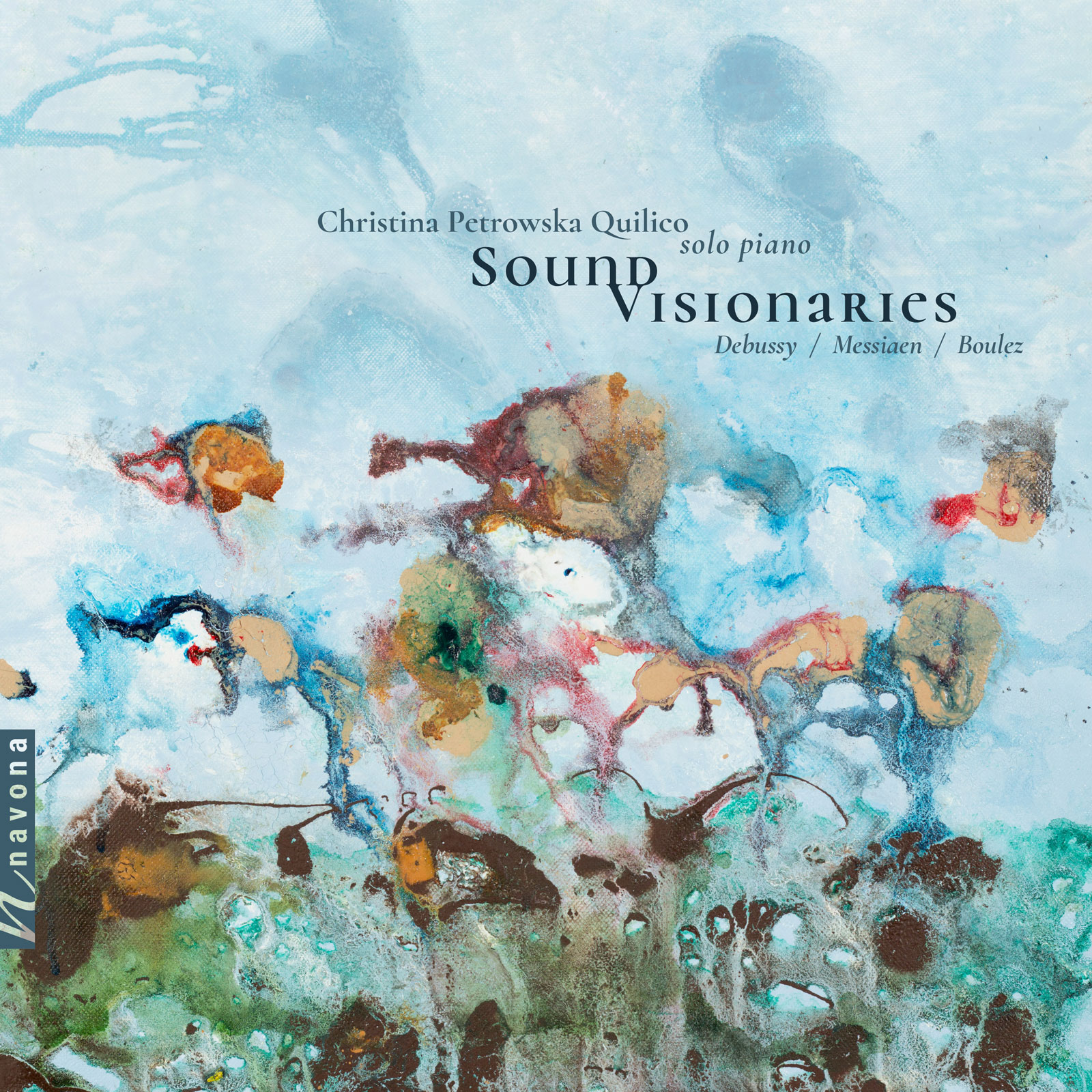Sound Visionaries
Christina Petrowska Quilico piano
Claude Debussy composer
Olivier Messiaen composer
Pierre Boulez composer
Claude Debussy, Olivier Messiaen, and Pierre Boulez are stunningly reconciled in Christina Petrowska Quilico’s Navona Records release SOUND VISIONARIES. Boasting a track record of over 50 recorded albums and having recently been named to the Order of Canada, the veteran pianist proves that despite all difficulties, finding common ground between these three composers can be done spectacularly.
The works in question are cleverly chosen: Debussy’s ethereal Preludes, Book Two is contrasted with Messiaen’s quasi-spiritual Vingt Regards Sur L’Enfant Jésus, and the album rounds off with Boulez’s atmospheric Première Sonate and Troisième Sonate. Petrowska Quilico unearths the modernity in the impressionist, the impressionism in the mystic, and the mysticism in the modernist. Sagacious, riveting, and indeed – visionary.
Listen
Stream/Buy
Choose your platform
"Her readings are technical triumphs but then always with the utmost musicality"
Track Listing & Credits
| # | Title | Composer | Performer | |
|---|---|---|---|---|
| 01 | Preludes, Book 2, L. 123 (Excerpts): No. 1, Brouillards | Claude Debussy | Christina Petrowska Quilico, piano | 2:24 |
| 02 | Preludes, Book 2, L. 123 (Excerpts): No. 2, Feuilles mortes | Claude Debussy | Christina Petrowska Quilico, piano | 2:42 |
| 03 | Preludes, Book 2, L. 123 (Excerpts): No. 3, La puerta del vino | Claude Debussy | Christina Petrowska Quilico, piano | 3:07 |
| 04 | Preludes, Book 2, L. 123 (Excerpts): No. 4, Les fées sont d'exquises danseuses | Claude Debussy | Christina Petrowska Quilico, piano | 2:30 |
| 05 | Preludes, Book 2, L. 123 (Excerpts): No. 7, La terrasse des audiences du clair de lune | Claude Debussy | Christina Petrowska Quilico, piano | 4:04 |
| 06 | Preludes, Book 2, L. 123 (Excerpts): No. 8, Ondine | Claude Debussy | Christina Petrowska Quilico, piano | 2:48 |
| 07 | Preludes, Book 2, L. 123 (Excerpts): No. 11, Les tierces alternées | Claude Debussy | Christina Petrowska Quilico, piano | 2:28 |
| 08 | Preludes, Book 2, L. 123 (Excerpts): No. 12, Feux d'artifice | Claude Debussy | Christina Petrowska Quilico, piano | 3:50 |
| 09 | Vingt regards sur l'enfant-Jésus, I/27 (Excerpts): No. 4, Regard de la vierge | Olivier Messiaen | Christina Petrowska Quilico, piano | 4:34 |
| 10 | Vingt regards sur l'enfant-Jésus, I/27 (Excerpts): No. 11, Première communion de la vierge | Olivier Messiaen | Christina Petrowska Quilico, piano | 5:55 |
| 11 | Vingt regards sur l'enfant-Jésus, I/27 (Excerpts): No. 16, Regard des prophètes, des bergers et des Mages | Olivier Messiaen | Christina Petrowska Quilico, piano | 3:20 |
| 12 | Vingt regards sur l'enfant-Jésus, I/27 (Excerpts): No. 2, Regard de l'étoile | Olivier Messiaen | Christina Petrowska Quilico, piano | 2:40 |
| 13 | Vingt regards sur l'enfant-Jésus, I/27 (Excerpts): No. 14, Regard des anges | Olivier Messiaen | Christina Petrowska Quilico, piano | 4:32 |
| 14 | Vingt regards sur l'enfant-Jésus, I/27 (Excerpts): No. 8, Regard des anges | Olivier Messiaen | Christina Petrowska Quilico, piano | 2:21 |
| 15 | Vingt regards sur l'enfant-Jésus, I/27 (Excerpts): No. 13, Noël | Olivier Messiaen | Christina Petrowska Quilico, piano | 3:29 |
| 16 | Piano Sonata No. 1 | Pierre Boulez | Christina Petrowska Quilico, piano | 10:15 |
| 17 | Piano Sonata No. 3: II. Trope | Pierre Boulez | Christina Petrowska Quilico, piano | 8:10 |
PRELUDES BOOK TWO & VINGT REGARDS SUR L’ENFANT-JÉSUS
Recorded at Harmonie German Canadian Club, Toronto ON, Canada
Session Producer Richard Coulter
Recording Session Engineer David Quinney
PREMIÈRE SONATE
Concert recorded live, September 2003, at the Glenn Gould Studio, Toronto ON, Canada for the Presentation of the Glenn Gould Prize to Pierre Boulez
Session Producer Mark Steinmetz
Recording Session Engineer Doug Doctor
TROISIÈME SONATE POUR PIANO
Recorded live at Walter Hall, University of Toronto in Toronto ON, Canada
Session Producer Richard Coulter
Recording Session Engineer David Quinney
Preludes, Vingt Regards, and Troisième Sonate are archival concert recordings originally aired by the Canadian Broadcasting Corporation. Music compiling and editing David Jaeger
Publicist, program notes editor Linda Litwack
Cover Art Christina Petrowska Quilico
General Manager of Audio & Sessions Jan Košulič
Audio Director, Addtl. Mastering Lucas Paquette
Executive Producer Bob Lord
Executive A&R Sam Renshaw
A&R Director Brandon MacNeil
VP, Design & Marketing Brett Picknell
Art Director Ryan Harrison
Design Edward A. Fleming
Publicity Patrick Niland, Sara Warner
Artist Information

Christina Petrowska Quilico
The Canadian Encyclopedia calls Christina Petrowska Quilico, C.M., O.Ont, FRSC, “one of Canada’s most celebrated pianists. Equally adept at Classical, Romantic and Contemporary repertoires… she is also a noted champion of Canadian composers.” She was appointed to the Order of Canada in 2020 “for her celebrated career as a classical and contemporary pianist, and for championing Canadian music” and to the Order of Ontario in 2022 “for opening the ears of music lovers through her performances and recordings, her teaching at York University and her establishment of The Christina and Louis Quilico Award at the Ontario Arts Foundation and Canadian Opera Company.”
Notes
All three French composers on this album were visionaries of their time. They shared an interest in Eastern music and were inspired by written art, especially the structures used by French poets Mallarmé, Baudelaire, and Rimbaud, novelist James Joyce, and other writers.
— Christina Petrowska Quilico, edited by Linda Litwack

